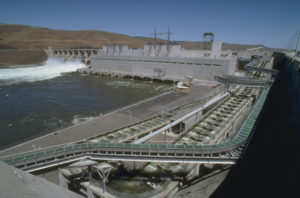Another failure of fish passage equipment at Little Goose Dam
Posted /Uncategorized
High river flows can be hazardous for smolts
Debris in bypass system blamed for death of salmon, steelhead young
- By ERIC BARKER of the Tribune
Debris carried by high flows on the Snake River continues to cause fish passage problems at Little Goose Dam, about 70 miles west of Lewiston.
Torn screens in the fish bypass system there led to the death of as many as 5,000 salmon and steelhead smolts earlier this month. The screens were torn by debris and trapped the ocean-bound fish in turbulent water, said U.S. Army Corps of Engineers spokesman Bruce Henrickson at the agency’s Walla Walla District.
He said agency officials don’t know exactly how many fish were killed during the incident that was first detected May 1 and took several days to remedy.
“At this point we believe it will be less than that 5,000 (estimate),” he said. “About 10 million juvenile salmon and steelhead pass Little Goose Dam this time of year. Of course every fish and every fish loss is important to us, but these are less than 5,000 out of 10 million.
The corps previously reported a clogged orifice in the fish bypass system killed 2,240 juvenile fish May 3, and 75 more perished in April because of problems also related to high flows and debris.
The latest problem was detected when an inspection with underwater cameras revealed damaged screens at three of the dam’s six hydro-electrical units. Henrickson said the units were dewatered and repaired one at a time. The last unit will come back online Wednesday.
The powerful springtime flows that help young fish navigate through reservoirs and past the dams generally are seen as a benefit to salmon and steelhead. Many of the migrating fish follow currents that take them over spillways, but others are drawn toward the turbines. The fish bypass system is designed to divert those smolts away from turbines and eventually around the dam.
This year’s high flows come at an inopportune time for Little Goose. In 2014, a barrier designed to divert debris away from the turbines and the accompanying fish bypass system at Little Goose was damaged. Henrickson said the 875-foot long structure was removed from the front of the dam but hasn’t yet been repaired and replaced.
“There is more debris in there than if we had our debris barrier in place,” he said. “In the meantime, flows are very high this year and therefore the debris (volume) is very high.”
The need to shut the units down during the repair led to an increase in the volume of water being spilled at the dam. While spill is seen by many scientists as the best way for the young fish to negotiate past the dams, the high volume of water plunging over spillways this year is producing elevated levels of dissolved gas. The work to repair the screens temporarily caused dissolved gas levels to rise even further. Extremely high levels of gas can harm the fish.
